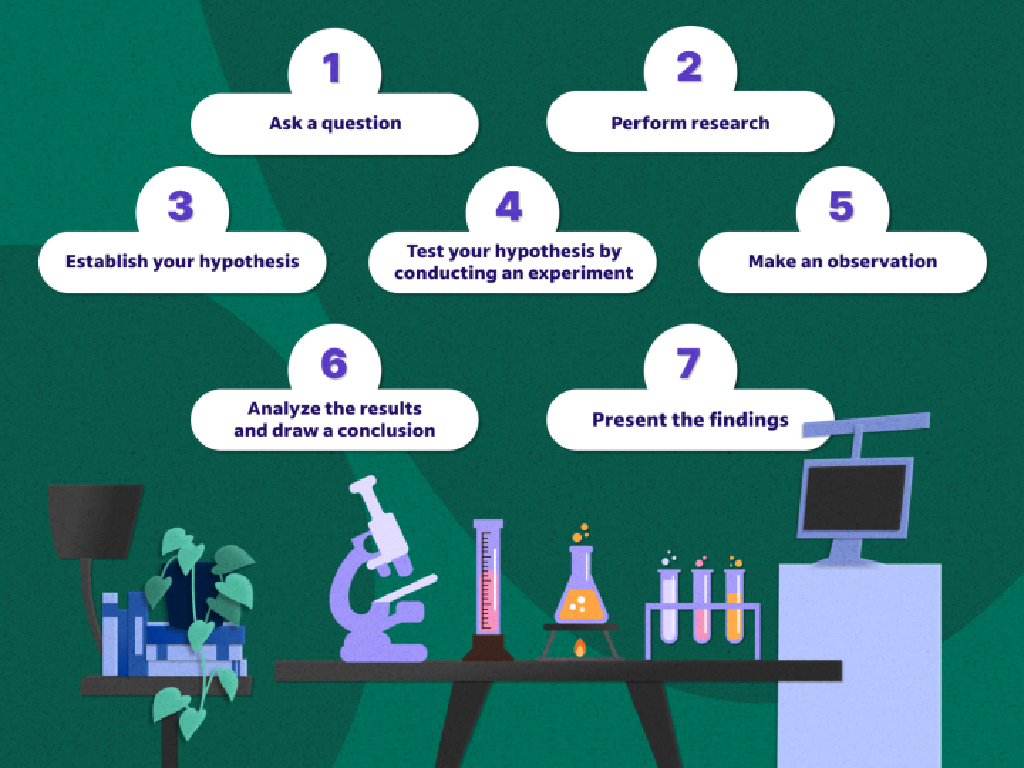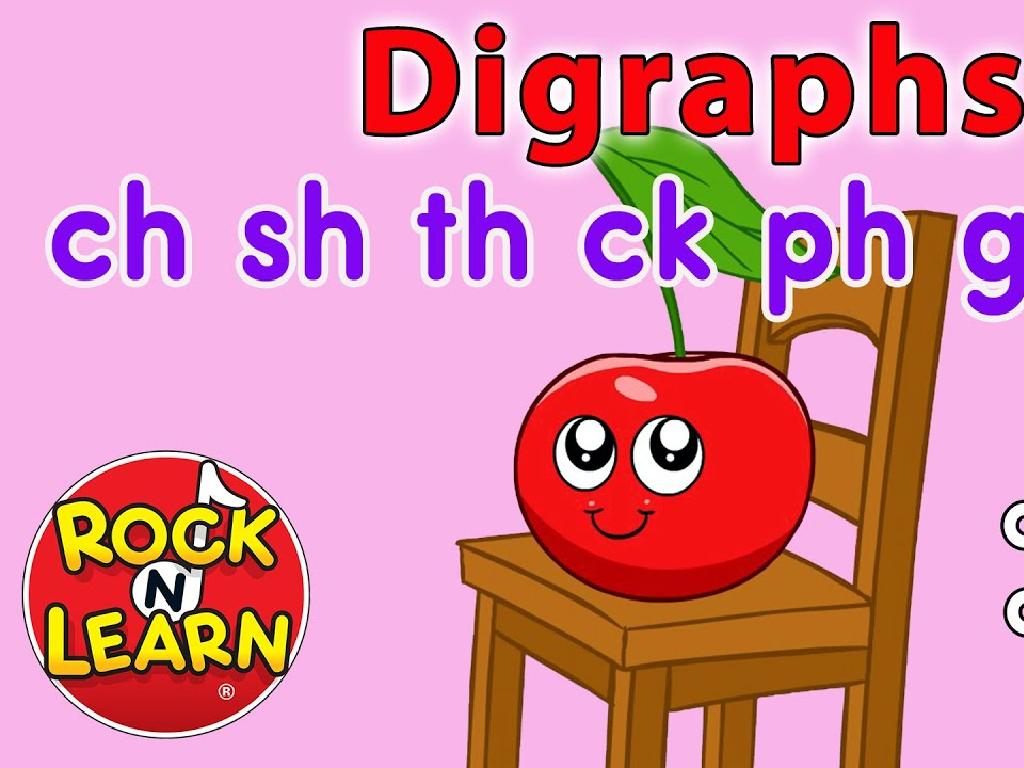Identify Homophones
Subject: Language arts
Grade: Second grade
Topic: Homophones
Please LOG IN to download the presentation. Access is available to registered users only.
View More Content
Welcome to Homophones!
– What are Homophones?
– Words that sound alike but have different meanings and spellings
– Sound the same, different meanings
– Like ‘pair’ (two things) and ‘pear’ (a fruit)
– Examples: ‘to’, ‘two’, ‘too’
– ‘To’ is for direction, ‘two’ is a number, ‘too’ means also
|
This slide introduces the concept of homophones to second-grade students. Homophones are words that sound the same when we say them, but they have different meanings and are often spelled differently. It’s important to use simple, clear examples that the students can relate to, such as ‘to’, ‘two’, and ‘too’. Explain that ‘to’ is used when talking about direction, ‘two’ is the number after one, and ‘too’ is used when you mean ‘also’ or ‘as well’. Encourage the students to think of other homophones they may already know and use them in sentences to show they understand the difference in meanings.
Understanding Homophones
– Homophones sound the same
– Words that are pronounced the same but may have different meanings
– Spelled differently, sound alike
– For example, ‘flower’ and ‘flour’
– Context reveals the meaning
– The words around homophones help us figure out which one is meant
– Practice makes perfect
|
Homophones are words that sound identical when we say them out loud but have different meanings and often different spellings. They can be confusing for young learners because they sound the same. To correctly understand and use homophones, students need to pay attention to the context in which the word is used. Context clues are the words and sentences that surround the homophone and can give hints about which word fits in the sentence. Encourage students to practice by using homophones in sentences and to listen carefully to how these words are used in conversations and stories. Provide examples and exercises where students can choose the correct homophone based on the context provided.
Homophone Examples
– Pair vs. Pear
– ‘Pair’ means two, ‘Pear’ is a yummy fruit.
– Son vs. Sun
– ‘Son’ is a child, ‘Sun’ shines bright in the sky.
– See vs. Sea
– ‘See’ is to look, ‘Sea’ is a big ocean.
|
This slide introduces students to the concept of homophones, which are words that sound the same but have different meanings and often different spellings. Use visual aids like pictures of a pair of socks, a pear, a boy and the sun, an eye, and an ocean to help students associate each word with its meaning. Encourage students to come up with sentences using each homophone to demonstrate their understanding. For example, ‘I have a pair of shoes.’ and ‘I ate a juicy pear.’ This will help solidify their grasp of homophones in a fun and interactive way.
Homophones in Sentences
– Understanding homophones
– ‘Sun’ shines in the sky
– The ‘sun’ gives us light and warmth
– ‘Son’ means a boy child
– ‘Son’ refers to someone’s male child
– Practice using both words
– Try to make sentences with ‘sun’ and ‘son’
|
This slide is aimed at helping second-grade students understand the concept of homophones words that sound the same but have different meanings and spellings. Use the examples provided to illustrate how the context of a sentence can help determine the meaning of homophones. Encourage the students to come up with their own sentences using the homophones ‘sun’ and ‘son’ to reinforce their understanding. You can also introduce additional homophone pairs and ask students to draw pictures or act out the meanings to create a fun and interactive learning experience.
Choosing the Right Homophone
– Understanding homophones
– Words that sound the same but have different meanings and spellings
– Meanings of each homophone
– Learn what each homophone means
– Using sentence clues
– Look for hints in the sentence to help you choose the right word
– Practice picking correctly
|
This slide is aimed at helping second-grade students understand how to correctly choose homophones in their writing. Begin by explaining what homophones are: words that sound alike but have different meanings and spellings, like ‘to,’ ‘two,’ and ‘too.’ Emphasize the importance of understanding the meaning of each homophone to use them correctly. Teach students to use context clues from the sentence to determine which homophone fits best. For example, ‘I went to the store,’ ‘I have two apples,’ and ‘I like ice cream, too.’ Encourage students to practice by providing sentences with missing homophones and asking them to fill in the blanks with the correct words. This will help reinforce their understanding and application of homophones in writing.
Homophone Matching Game
– Let’s play a matching game!
– Find pairs that sound alike
– Words like ‘pair’ and ‘pear’ are homophones
– Different meanings and spellings
– For example, ‘sea’ and ‘see’ or ‘night’ and ‘knight’
– Have fun learning homophones!
|
This slide introduces a class activity focused on homophones, which are words that sound the same but have different meanings and spellings. The objective is to help students recognize and match pairs of homophones. For the activity, prepare a set of homophone cards in advance. Each card should have one word, and there should be a matching card with its homophone. During the activity, students will try to find and match the pairs. This game will enhance their listening skills and understanding of homophones. Some possible pairs to include are ‘flower’ and ‘flour’, ‘blue’ and ‘blew’, ‘son’ and ‘sun’, ‘hole’ and ‘whole’. After the game, discuss the different meanings of each pair to reinforce their learning.
Class Activity: Homophone Hunt
– Find homophones in a favorite book
– Write down the homophone pairs
– Example: ‘pair’ and ‘pear’
– Share your homophone pairs in class
– Understand homophones usage
– Learn how homophones sound the same but have different meanings and spellings
|
This activity is designed to help students recognize and understand homophones words that sound the same but have different meanings and spellings. Encourage students to pick a book they enjoy and look for homophones as they read. They should write down each pair they find, such as ‘sea’ and ‘see’ or ‘night’ and ‘knight’. After collecting a few pairs, students will share their findings with the class, which will help reinforce their understanding and provide a fun way to learn from each other. For the teacher: prepare a list of common homophones as examples, and be ready to guide students who may need help identifying them in their books.




